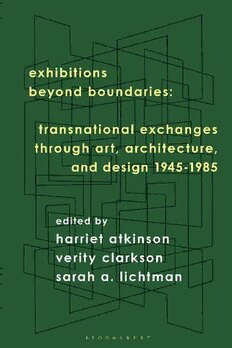
Exhibitions Beyond Boundaries: Transnational Exchanges through Art, Architecture, and Design 1945–1985 PDF
321 Pages·2022·71.601 MB·English
Most books are stored in the elastic cloud where traffic is expensive. For this reason, we have a limit on daily download.
Preview Exhibitions Beyond Boundaries: Transnational Exchanges through Art, Architecture, and Design 1945–1985
Description:
After the end of World War II, museum and gallery exhibitions, industrial and trade fairs, biennials, triennials, festivals and world’s fairs all came increasingly to be used as locations for the exercise of ‘soft power’, for displays of cultural diplomacy between nations and as spaces for addressing areas of social and political contestation. This book reflects on approaches to the study of exhibitions within and beyond the disciplinary boundaries of art and design history. It also explores the wider networks and relationships that are engendered through exhibitions.Exhibitions Beyond Boundaries traces relations across a wide set of geographies: Africa, Asia, Europe, the Middle East, the Pacific and the USA. It draws on a range of methodologies and interdisciplinary perspectives principally from art and design history but also from social, economic and political history and museum studies. Featured case studies include explorations of the life and work of Misha Black, Belgo-American exchanges during the Cold War, Israel’s appearance at the 1948-1952 Venice Biennale and the Vatican Pavilion at the 1964-1965 New York World’s Fair. This book’s impressively global scope is in line with its outward-looking subject matter and its international line up of contributors further underlines this.
See more
The list of books you might like
Most books are stored in the elastic cloud where traffic is expensive. For this reason, we have a limit on daily download.
